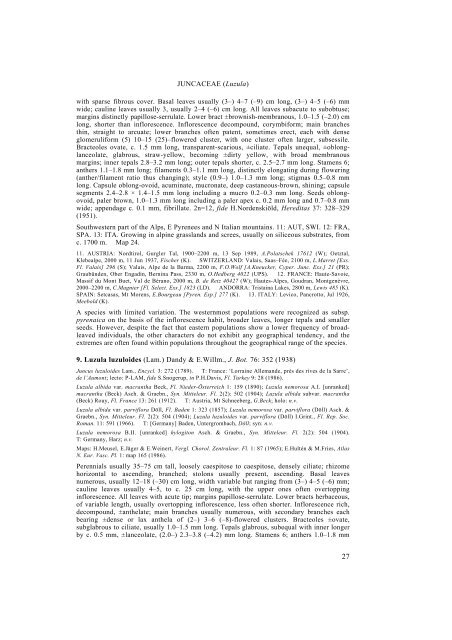Part 6. JUNCACEAE 1: Rostkovia to Luzula - Species Plantarum ...
Part 6. JUNCACEAE 1: Rostkovia to Luzula - Species Plantarum ...
Part 6. JUNCACEAE 1: Rostkovia to Luzula - Species Plantarum ...
Create successful ePaper yourself
Turn your PDF publications into a flip-book with our unique Google optimized e-Paper software.
<strong>JUNCACEAE</strong> (<strong>Luzula</strong>)<br />
with sparse fibrous cover. Basal leaves usually (3–) 4–7 (–9) cm long, (3–) 4–5 (–6) mm<br />
wide; cauline leaves usually 3, usually 2–4 (–6) cm long. All leaves subacute <strong>to</strong> subobtuse;<br />
margins distinctly papillose-serrulate. Lower bract ±brownish-membranous, 1.0–1.5 (–2.0) cm<br />
long, shorter than inflorescence. Inflorescence decompound, corymbiform; main branches<br />
thin, straight <strong>to</strong> arcuate; lower branches often patent, sometimes erect, each with dense<br />
glomeruliform (5) 10–15 (25)–flowered cluster, with one cluster often larger, subsessile.<br />
Bracteoles ovate, c. 1.5 mm long, transparent-scarious, ±ciliate. Tepals unequal, ±oblonglanceolate,<br />
glabrous, straw-yellow, becoming ±dirty yellow, with broad membranous<br />
margins; inner tepals 2.8–3.2 mm long; outer tepals shorter, c. 2.5–2.7 mm long. Stamens 6;<br />
anthers 1.1–1.8 mm long; filaments 0.3–1.1 mm long, distinctly elongating during flowering<br />
(anther/filament ratio thus changing); style (0.9–) 1.0–1.3 mm long; stigmas 0.5–0.8 mm<br />
long. Capsule oblong-ovoid, acuminate, mucronate, deep castaneous-brown, shining; capsule<br />
segments 2.4–2.8 × 1.4–1.5 mm long including a mucro 0.2–0.3 mm long. Seeds oblongovoid,<br />
paler brown, 1.0–1.3 mm long including a paler apex c. 0.2 mm long and 0.7–0.8 mm<br />
wide; appendage c. 0.1 mm, fibrillate. 2n=12, fide H.Nordenskiöld, Hereditas 37: 328–329<br />
(1951).<br />
Southwestern part of the Alps, E Pyrenees and N Italian mountains. 11: AUT, SWI. 12: FRA,<br />
SPA. 13: ITA. Growing in alpine grasslands and screes, usually on siliceous substrates, from<br />
c. 1700 m. Map 24.<br />
11. AUSTRIA: Nordtirol, Gurgler Tal, 1900–2200 m, 13 Sep 1989, A.Polatschek 17612 (W); Oetztal,<br />
Klebealpe, 2000 m, 11 Jun 1937, Fischer (K). SWITZERLAND: Valais, Saas–Fée, 2100 m, L.Marret [Exs.<br />
Fl. Valais] 296 (S); Valais, Alpe de la Barma, 2200 m, F.O.Wolf [A.Kneucker, Cyper. Junc. Exs.] 21 (PR);<br />
Graubünden, Ober Engadin, Bernina Pass, 2330 m, O.Hedberg 4022 (UPS). 12. FRANCE: Haute-Savoie,<br />
Massif du Mont Buet, Val de Bérano, 2000 m, B. de Retz 40427 (W); Hautes-Alpes, Goudran, Montgenèvre,<br />
2000–2200 m, C.Magnier [Fl. Select. Exs.] 1823 (LD). ANDORRA: Tristaina Lakes, 2800 m, Lewis 485 (K).<br />
SPAIN: Setcasas, Mt Morens, E.Bourgeau [Pyren. Esp.] 277 (K). 13. ITALY: Levico, Pancrot<strong>to</strong>, Jul 1926,<br />
Meebold (K).<br />
A species with limited variation. The westernmost populations were recognized as subsp.<br />
pyrenaica on the basis of the inflorescence habit, broader leaves, longer tepals and smaller<br />
seeds. However, despite the fact that eastern populations show a lower frequency of broadleaved<br />
individuals, the other characters do not exhibit any geographical tendency, and the<br />
extremes are often found within populations throughout the geographical range of the species.<br />
9. <strong>Luzula</strong> luzuloides (Lam.) Dandy & E.Willm., J. Bot. 76: 352 (1938)<br />
Juncus luzuloides Lam., Encycl. 3: 272 (1789). T: France: ‘Lorraine Allemande, près des rives de la Sarre’,<br />
de l’Aumont; lec<strong>to</strong>: P-LAM, fide S.Snogerup, in P.H.Davis, Fl. Turkey 9: 28 (1986).<br />
<strong>Luzula</strong> albida var. macrantha Beck, Fl. Nieder-Österreich 1: 159 (1890); <strong>Luzula</strong> nemorosa A.I. [unranked]<br />
macrantha (Beck) Asch. & Graebn., Syn. Mitteleur. Fl. 2(2): 502 (1904); <strong>Luzula</strong> albida subvar. macrantha<br />
(Beck) Rouy, Fl. France 13: 261 (1912). T: Austria, Mt Schneeberg, G.Beck; holo: n.v.<br />
<strong>Luzula</strong> albida var. parviflora Döll, Fl. Baden 1: 323 (1857); <strong>Luzula</strong> nemorosa var. parviflora (Döll) Asch. &<br />
Graebn., Syn. Mitteleur. Fl. 2(2): 504 (1904); <strong>Luzula</strong> luzuloides var. parviflora (Döll) I.Grint., Fl. Rep. Soc.<br />
Roman. 11: 591 (1966). T: [Germany] Baden, Untergrombach, Döll; syn: n.v.<br />
<strong>Luzula</strong> nemorosa B.II. [unranked] hylogi<strong>to</strong>n Asch. & Graebn., Syn. Mitteleur. Fl. 2(2): 504 (1904).<br />
T: Germany, Harz; n.v.<br />
Maps: H.Meusel, E.Jäger & E.Weinert, Vergl. Chorol. Zentraleur. Fl. 1: 87 (1965); E.Hultén & M.Fries, Atlas<br />
N. Eur. Vasc. Pl. 1: map 165 (1986).<br />
Perennials usually 35–75 cm tall, loosely caespi<strong>to</strong>se <strong>to</strong> caespi<strong>to</strong>se, densely ciliate; rhizome<br />
horizontal <strong>to</strong> ascending, branched; s<strong>to</strong>lons usually present, ascending. Basal leaves<br />
numerous, usually 12–18 (–30) cm long, width variable but ranging from (3–) 4–5 (–6) mm;<br />
cauline leaves usually 4–5, <strong>to</strong> c. 25 cm long, with the upper ones often over<strong>to</strong>pping<br />
inflorescence. All leaves with acute tip; margins papillose-serrulate. Lower bracts herbaceous,<br />
of variable length, usually over<strong>to</strong>pping inflorescence, less often shorter. Inflorescence rich,<br />
decompound, ±anthelate; main branches usually numerous, with secondary branches each<br />
bearing ±dense or lax anthela of (2–) 3–6 (–8)-flowered clusters. Bracteoles ±ovate,<br />
subglabrous <strong>to</strong> ciliate, usually 1.0–1.5 mm long. Tepals glabrous, subequal with inner longer<br />
by c. 0.5 mm, ±lanceolate, (2.0–) 2.3–3.8 (–4.2) mm long. Stamens 6; anthers 1.0–1.8 mm<br />
27












